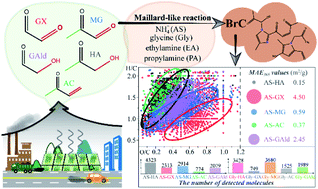Unexpected molecular diversity of brown carbon formed by Maillard-like reactions in aqueous aerosols†
Abstract
Atmospheric brown carbon (BrC) exerts a key impact on the global radiative balance due to its light-absorbing properties. Maillard-like reactions between carbonyl and amino compounds have been identified as an important pathway for forming secondary BrC. Although optical properties have been widely studied, the molecular composition of secondary BrC generated in Maillard chemistry remains unclear, resulting in a knowledge gap to understand its formation and light-absorbing mechanism. In this study, a combination of optical spectroscopy, 1H nuclear magnetic resonance (NMR), and Fourier transform ion cyclotron resonance mass spectrometry (FT-ICR MS) was employed to comprehensively characterize the chemical and light-absorbing characteristics of secondary BrC. The results indicate that both the light-absorbing and molecular characteristics of secondary BrC were highly related to the structures of their precursors. Organic amine precursors consistently result in enhanced light-absorbing capacities of BrC compared to ammonium, but have inconsistent effects on the molecular diversity of BrC. Compared to amino precursors (i.e., glycine, ethylamine, propylamine, and ammonium), carbonyl precursors play a more important role in determining the molecular diversity of BrC. Different from black carbon, the light-absorbing products from Maillard-like reactions are mainly nitrogen-containing heterocycles. Unexpectedly, 35–64% of molecular formulae detected in real atmospheric samples were found in simulated Maillard reaction products, implying a potentially important contribution of Maillard chemistry to the atmospheric organic molecular pool. These results will improve our understanding of the formation and molecular diversity of BrC, and further help to manage emissions of secondary aerosol precursors.



 Please wait while we load your content...
Please wait while we load your content...